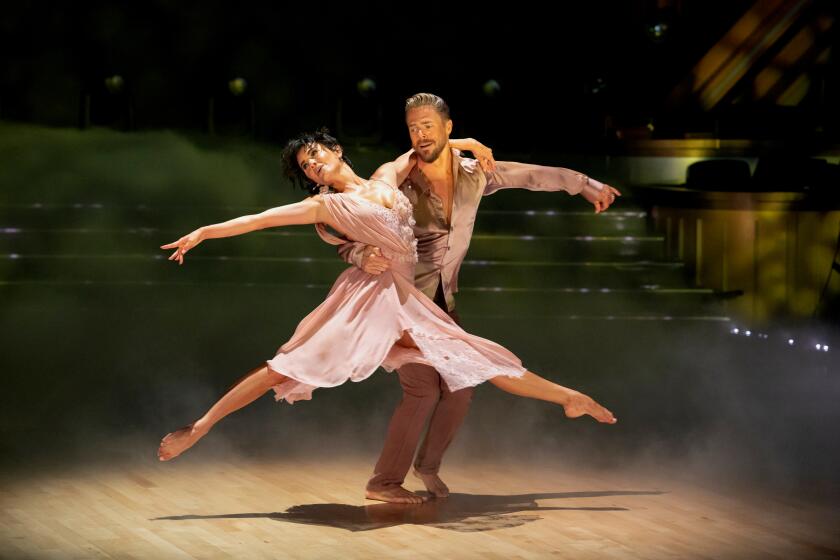ART REVIEW : A Voyage to Inner Space at Ace Gallery
Thereâs no other gallery in Los Angeles--maybe in the entire country--remotely like Ace Contemporary Exhibitions. An architectural extravaganza worthy of Albert Speer, Ace is a staggeringly huge network of galleries with high ceilings, concrete floors and the hushed ambience of a cathedral of high culture. Itâs a most impressive little shop.
Located in the Miracle Mile in a Deco Wilshire Boulevard building emblazoned with âDesmonds,â Ace has 30,000 square feet of floor space to accommodate the kind of big, ambitious art one usually has to go to a museum to see. Its current show, âThe Innovators/Entering the Sculpture,â on view through December, more than holds its own with anything currently on view in our local museums.
A history lesson in the central sculptural developments of the past 20 years, âThe Innovatorsâ showcases important works by all the major dudes-- dudes is an operative word here too, as this is decidedly macho art. In fact, thereâs not a single woman among the 14 artists included, all of whom came into prominence during the period when the materials of choice for sculptors were steel, concrete, heavy earth-moving equipment and more steel. Sissies need not apply.
A gallery flyer explains the exhibitionâs focus on artists whose work is stimulated by specific sites, artists who destroy the traditional relationship between sculptural objects and their surroundings (away with pedestals!), and artists who make self-referential objects that read as gestalts. Emphatically anti-narrative and a trifle cold, this work lures one into strange psychological terrain and offers little assistance in getting the lay of the land--the viewer is on his own with this art, much of which is highly disorienting. Finally, these artists concern themselves with the working out of ideas rather than the actual making of pieces, and often contract out the hands-on step of the art-making process. What we have here, in other words, is Minimalism, Conceptualism, Earthworks and process art.
A beautifully installed show, âThe Innovatorsâ kicks off with âLozenge,â a concrete-and-steel work from 1986 by Jean Highstein. A weird hybrid of the organic and the industrial, âLozengeâ looks like a gigantic cigar welded onto a low pedestal; at once phallic and comical, itâs an oddly unsettling piece. In a distant gallery is another untitled work by Highstein thatâs even more bizarre. Working with wood, plaster and wire, Highstein has fashioned a huge form that emerges from the wall like the snout of a gigantic whale.
Seminal conceptualist Bruce Nauman shows âFloating Room,â a work from 1972 thatâs basically a square room built within a slightly larger square room. The art part is in the fact that the smaller room is suspended from the ceiling so that it hovers an inch or two above the floor. Enter the small unlit room and a halo of light hums at the base of the floor.
Minimalist master Dan Flavin shows an untitled piece from 1975-82 that involves 20 vertical fluorescent neon tubes. Facing us are 10 pink tubes, facing away from us are 10 green ones; the glaring bands of color come together to form a shrieking hard edge painting made of light.
James Turrell, one of the founding fathers of the cool, metaphysical school known as California light and space art, also paints with light, and âStuck,â a Turrell piece from 1970, is a classic work of this genre. A large room is left dark but for two recessed areas cut into opposing corners at waist level, which are lit from within--one with red light, one with blue. From a distance these âlight boxesâ read as flat surfaces on the wall. Approach them and stick your head inside the recessed area and you experience a Ganzfeld , a meditation device that affects the peripheral vision. (Sundayâs Calendar will explore Turrellâs long effort to transform an Arizona volcano crater into an extraordinary observatory.)
Even more than the highly regarded Turrell, Robert Irwin is considered the grand poobah of light art, and his series of âDisksâ--the one here is from 1967--marks a point when painting dissolved into pure consciousness. A cast-aluminum disc coated with white acrylic paint is installed so that it floats a few feet in front of the wall, and is lit in such a way that shadows meld with the form to create a mysterious flower of light.
Three leading proponents of heavy-metal Minimalism--Richard Serra, Carl Andre and Richard Nonas--are generously represented with various configurations of steel. Andre arranges rolled steel plates on the floor, Serra recesses a steel plate into the floor and sets another on top of the floor for a piece called âOn-In,â and Nonas leans identical blocks of steel against the wall in symmetrical rows. Ostentatiously male and not a little austere, this work will never be accused of excessive whimsy.
Work by Gordon Matta-Clark, on the other hand, was delightfully playful, and his death in 1978 at the age of 35 from cancer was a great loss for the art world. Matta-Clark was known for appropriating abandoned buildings and using them as a canvas--heâd slice entire buildings in half, or cut holes here and there to create a symphony of positive and negative space. Matta-Clark is represented here by âOpen House,â an industrial dumpster that houses a maze of narrow hallways and doors assembled from scavenged materials.
Also on view are pieces by legendary Earthworks artist Robert Smithson, Michael Heizer, Richard Long and Donald Judd. As spectacular as any piece in the show, however, is Ace itself. Itâs the only gallery in Los Angeles you can get lost in.
More to Read
The biggest entertainment stories
Get our big stories about Hollywood, film, television, music, arts, culture and more right in your inbox as soon as they publish.
You may occasionally receive promotional content from the Los Angeles Times.










